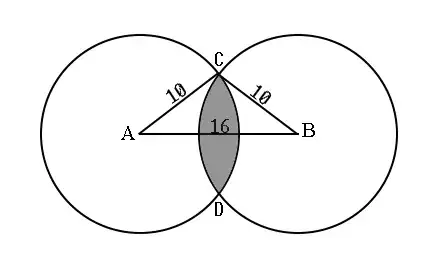Though some clever trigonometry, algebra, and substitutions, one can derive a general solution to this problem. This problem was solved by Artemas Martin with a solution published in the Analyst (https://www.jstor.org/stable/2635978).
The key idea is to consider one circle fixed and the other with variable radius. Examining how a differential increase in radius relates to a differential increase in the intersection area you will obtain the following relationship.
$$dA = 2x \cos^{-1}\left(\frac{x^2 + a^2 - r^2}{2ax}\right)dx $$ where x is the variable radius, r is the fixed radius, and a is the distance between their centers. Note the limits of integration are r-a and x.
Through some nonobvious manipulations (perhaps even some kind of wizardry) this integral has the following solution (refer to paper for a rough sketch, but some details you will have to work out on your own).
$$A = x^2\cos^{-1}\left(\frac{x^2 + a^2 - r^2}{2ax}\right) + r^2\cos^{-1}\left(\frac{a^2 + r^2 - x^2}{2ar}\right) - a\sqrt{r^2 - \left ( \frac{a^2 + r^2 - x^2}{2a}\right )^2}$$
Substitute x = R for a specific radius to determine the area of intersection.
Note.
There is a typo in the paper in one step of the derivation. Specifically the last equation on the first page. The right hand side should read $$r^2 \cos^{-1}\left(\frac{y}{2ar}\right) - \frac{1}{2} \sqrt{4a^2r^2 - y^2}$$
